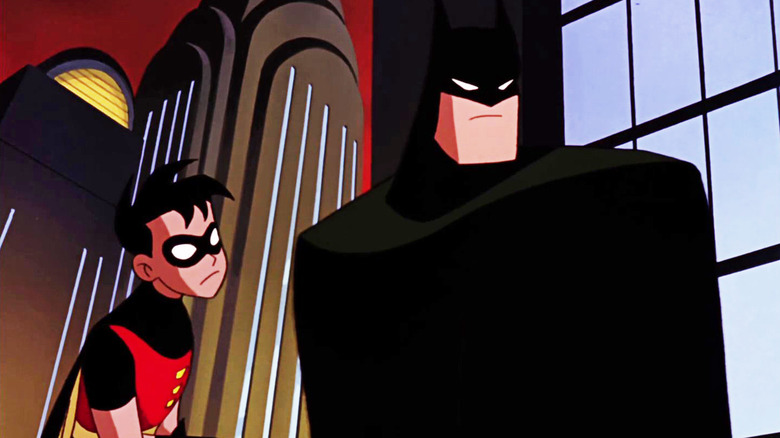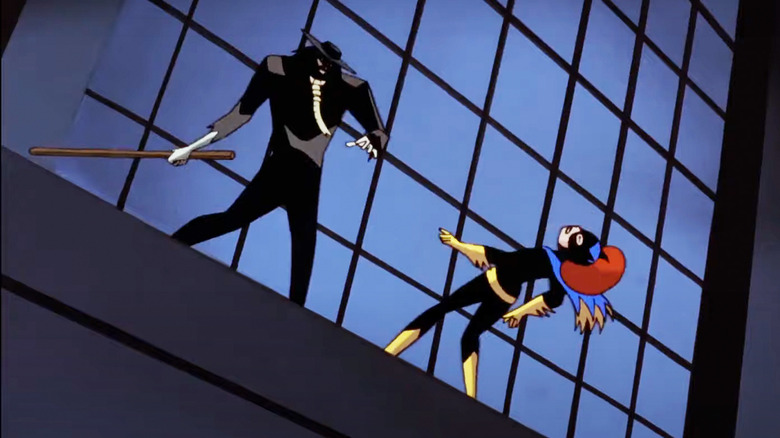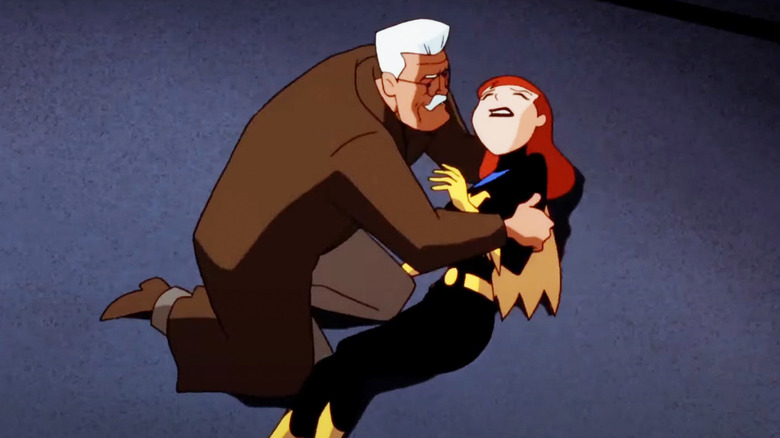The New Batman Adventures Series Used Scarecrow To Pull One Over On The Censors
After "Batman: The Animated Series" ended its legendary run on Fox Kids in 1997, fans of the show were mercifully given a further two seasons (sort of) when Kids' WB stepped in. Debuting in 1998, "The New Batman Adventures" served as a kind of continuation/sequel to Bruce Timm and Eric Radomski's seminal show, updating the memorable "Batman: TAS" design style and shifting the focus from the Dark Knight to members of the Bat family and other Gothamites.
Joined by Robin, Nightwing, and Batgirl, Batman would become a more stern figure in this follow-up series, which aired alongside Timm's "Superman: The Animated Series" and helped expand the DC Animated Universe. This show did away with elements of its predecessor's darker, noirish aesthetic and simplified Batman, Joker, and other characters' looks.
But while much changed between Timm's original series and its follow-up, much of the behind-the-scenes processes stayed the same, including navigating the censors. Timm and his team famously had numerous run-ins with the Standards and Practices department, developing neat tricks to get around censor notes such as deploying "decoys" — obvious breaches of the rules designed to distract censors from what they actually wanted to include in the episode. That practice of skirting the guidelines in novel ways continued with "The New Batman Adventures," perhaps most notably with episode 11, "Over the Edge," in which Batgirl seemingly dies and Commissioner Gordon blames Batman. Naturally, death of any kind in a kids' show was always going to be an issue for the censors, but Timm's team, as ever, had a trick up their sleeve.
It was all a dream
"Over The Edge" kicks things off in dramatic style when Barbara Gordon as Batgirl is knocked off a building by Scarecrow before landing on the hood of a car carrying her own dad, Commissioner Gordon. She then dies in her father's arms (yes, this was a kids' show) in what is one of the most poignant and emotional scenes from the entire show's run. But as the legendary voice actor behind Batman, Kevin Conroy, told Vulture: "In animation, you can't actually kill anybody. Standards and practices won't allow that."
To get around this little wrinkle in their plan, the writing team used a few tactics. By the end of the episode, we discover that Barbara's death and the ensuing war between her father and the Bat family was all a hallucination brought on by Scarecrow's fear toxin. That went a long way towards placating the censors. Speaking to ScienceFiction.com, Timm revealed that "Over The Edge" was one of his personal favorite moments from the Kids' WB era simply because he "really pulled one over on the Broadcast Standards and Practice people."
"Even though it's a dream, and that's kind of a cheat, I feel that the episode kind of earns that cheat so that by the end of it you don't go, 'Oh it's all a dream?' Because we're telling you from the beginning, the second you see Scarecrow show up you know it's not real. But that was a really good episode! And that whole bit where we get to kill Batgirl, it was kind of fun! Because we got to play with people's emotions."
Clever camera angles
Beyond using the "it was all a dream" excuse, Timm was required to make some other changes to the death sequence. As Dorkly explains, when Batgirl hits the car carrying her dad, instead of using a wide exterior shot, the team switched it to an interior shot from Gordon's perspective. In an example of Timm's habit for following censor notes while somehow making everything worse, this new perspective was arguably even more disturbing.
This wasn't the first time Timm had to switch up camera angles to appease the censors. A similar change was made to the two-part story "Robin's Reckoning," from the "Batman: TAS" days. In Vulture's oral history of the show, Timm recalled how "almost every episode, we would get a huge list of things we couldn't do," which basically amounted to a list of nine things the show had to avoid. That made it difficult to depict the death of Dick Grayson's parents convincingly.
The episodes were supposed to show Grayson's acrobat parents falling during a trapeze performance, but that was pretty much out of the question. So, as co-creator Eric Radomski explained: "We came up with the idea of the trapeze ropes going through the scene with a spotlight on them, and then coming back with one sheared rope and stinging with appropriate music." That approach paid off, with "Robin's Reckoning" winning the Emmy for Outstanding Animated Program.
As "Robin's Reckoning" and "Over The Edge" show, the ongoing censorship issues often improved the show. And while Timm and his colleagues were no fans of censorship, the way they took censor notes almost as a challenge to come up with inventive ways of getting their ideas across is one of the reasons the '90s Batman shows are so fondly remembered.


